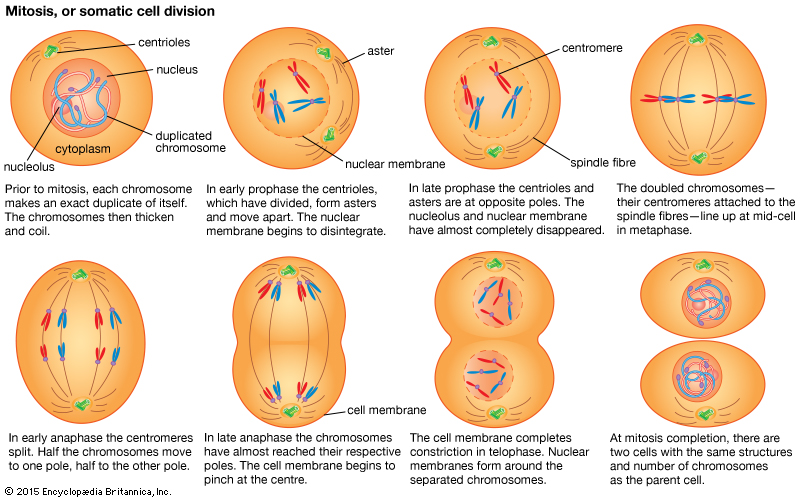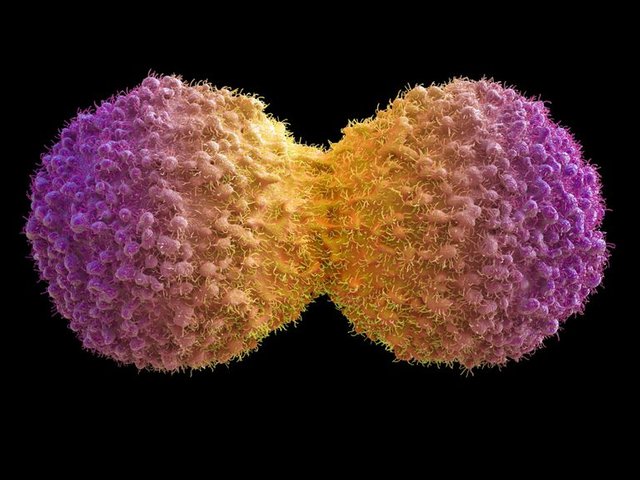mitosis cell division. this post contains video please check it (now with 21000sp more than 2$ upvote)good luck
hello my friends. doctor steemit is here again now 21000sp power more 2$ upvote makes the profitable post for you and you can get the information about the cell division which is mitosis.
Mitosis is a type of cell division in which one cell (the mother) divides to produce two new cells (the daughters) that are genetically identical to itself. In the context of the cell cycle, mitosis is the part of the division process in which the DNA of the cell's nucleus is split into two equal sets of chromosomes.
Before a dividing cell enters mitosis, it undergoes a period of growth called interphase. Some 90 percent of a cell's time in the normal cellular cycle may be spent in interphase.
interphase has some stages which im going to mention here for you.
1.interphase: stages
Gap 0 (G0): There are times when a cell will leave the cycle and quit dividing. This may be a temporary resting period or more permanent. An example of the latter is a cell that has reached an end stage of development and will no longer divide (e.g. neuron).
Growth:
multicellular organisms can grow in two ways, increasing the size of their cells, or increasing the number of cells - achieved through mitosis.
S PHASE
After passing through the first internal checkpoint, the cell enters the S phase, or synthesis phase. During the S phase, DNA is duplicated so that each chromosome contains two identical copies. These DNA copies do not separate into duplicate chromosomes until after the interphase stages end and mitosis or cell nucleus division begins.
Gap 2 (G2):
During the gap between DNA synthesis and mitosis, the cell will continue to grow and produce new proteins. At the end of this gap is another control checkpoint (G2 Checkpoint) to determine if the cell can now proceed to enter M (mitosis) and divide.
2.Prophase:(stage)
Prophase is the first phase of mitosis, the process that separates the duplicated genetic material carried in the nucleus of a parent cell into two identical daughter cells. During prophase, the complex of DNA and proteins contained in the nucleus, known as chromatin, condenses. The chromatin coils and becomes increasingly compact, resulting in the formation of visible chromosomes.
3.Metaphase:
Metaphase is marked by the alignment of chromosomes at the center of the cell, halfway between each of the mitotic spindle poles. Movement is mediated by the kinetochore microtubules, which push and pull on the chromosomes to align them into what is called the metaphase plate.
The nuclear membrane disappears completely.
In animal cells, the two pair of centrioles align at opposite poles of the cell.
Polar fibers (microtubules that make up the spindle fibers) continue to extend from the poles to the center of the cell.
Chromosomes move randomly until they attach (at their kinetochores) to polar fibers from both sides of their centromeres.
Chromosomes align at the metaphase plate at right angles to the spindle poles.
4.Anaphase:
Anaphase begins when the duplicated centromeres of each pair of sister chromatids separate, and the now-daughter chromosomes begin moving toward opposite poles of the cell due to the action of the spindle.
Depending where the centromere is located along the chromosome, a characteristic shape appears during chromosome movement. The two shown above give V and J shapes.
At the end of anaphase, a complete set of chromosomes has assembled at each pole of the cell.
5.Telophase:
Chromatids arrive at opposite poles of cell, and new membranes form around the daughter nuclei. The chromosomes disperse and are no longer visible under the light microscope. The spindle fibers disperse, and cytokinesis or the partitioning of the cell may also begin during this stage.

source photo:https://www.britannica.com/science/mitosis
CYTOKINESIS:
Cytokinesis is the process in which the cell actually divides into two. With the two nuclei already at opposite poles of the cell, the cell cytoplasm separates, and the cell pinches in the middle, ultimately leading to cleavage. In most cells, the mitotic spindle determines the site where the cell will begin to invaginate and split.
6.Daughter Cells:
At the end of mitosis and cytokinesis, chromosomes are equally distributed between two daughter cells. These cells are identical diploid cells, with each cell containing a full complement of chromosomes.

source photo:https://www.thoughtco.com/daughter-cells-defined-4024745
link video:




nice post my friend thanks for sharing please make post about replication of DNA
science is really exciting!
In Quantum, there is no distinguish between biology & physic.
All life & cells are designed within physics...